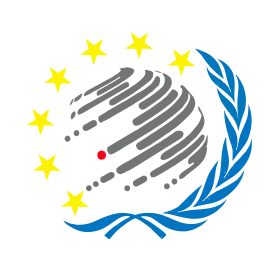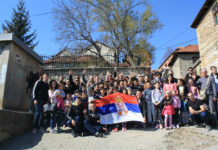History repeats itself – two Koreas will march together under one flag during the opening ceremony of the Winter Olympics, which will be held in Pyeongchang, a city only 80 kilometres away from the most heavily guarded border in the world, the DMZ[1]. This is not the first off such efforts, as North and South Korean athletes have marched together during opening ceremonies in 2002, 2004 and 2006. All of these big steps towards reconciliation came after one of the sides decided to loosen up its demagogy and policies against the other.
North and South Korea are again having vis-à-vis[2] communication, in the most important barracks in the word, at Joint Security Area. This time, it was the North arranging the tables. After being heavily hit by sanctions, despite the warmongering rhetoric, the Kim regime installs the red communication line and decides to participate and even to take part together with their Southern compatriots at the Winter Olympics. For many this came as a surprise, but to those who scratch a bit under the surface, they notice profound geopolitical and even existential roots to this sudden blossoming and “sunshine”[3] in their relations.
Geopolitical events that have been unfolding during the last year have invoked a need that is so far unprecedented in the relations between the two Koreas. Rapid changes in the developments of the Eurasian continent is for some an impetus for more economic (or any) cooperation on the Korean peninsula. The Chinese One Belt, One Road initiative, Yamal and Trans-Caspian pipeline projects, turmoil in Iran and the exponential growth in the South East Asia region will inevitably force North and South to have combined projects and efforts. North Korea has been seriously affected by the new sanction imposed by the Security Council of the UN, which has significantly cut its oil and natural gas imports and banned North Korean workers from working abroad in the future. This will have enormous implications to the enclosed economy in the long run, but it won’t truthfully deter the regime from continuing development on nuclear and ballistic capabilities. Thus, this nuclear issue will still pose a major threat, especially to South Korea and Japan, but paradoxically it will be a leverage in the negotiations that the North will instigate if ever needed. And consequently, as the praxis has shown, that move will automatically stop any further talks.
The so far best accomplishment of the “sunshine” policy was the establishment of Kaesong industrial region, which on one side granted cheap labour to the South, and essential assets in foreign currencies. This compound has at its pinnacle had 123 South Korean companies with more than 53.000 North Korean employees, with a note that the wages were paid to the regime in Pyongyang, and not to the workers. Because of tumultuous events that unfolded in 2016. (5th North Korean nuclear test), the region was shut down, but implications of it being reopened will be more and more evident. So far, these implications are coming solely from Seoul, as the new regime of Moon Jae-In is having to fear for its protection under the American nuclear umbrella.
Trumps remarks only propelled the need to be ready to again instigate the talks with DPRK, as only direct and sincere rapprochements can divert the region from becoming filled with nuclear fallout. This time, the call come somewhat predictably from Pyongyang, as the aforementioned sanctions will have a long-lasting effect, if they continue to be implemented by all members of the Security Council. The fact that Washington is slowly decreasing its overall presence in the region, as the Trump administration looks to make the country great again. Its military will still be present though, but the guarantee is nearing its expiration date. Economic reasons will strive both parties to, without any foreign intervention, to engage in talks and negotiations, as that is virtually the only way that reunification can happen. Even though this won’t be appreciated in the US, the leverage that it holds on Seoul is also gradually diminishing, as regional cooperation is the key to keep one of the tigers of Asia competitive and innovating.
The breakthrough in the relations between the DPRK and ROK could this time be more far reaching than ever. North Korea must, if it wants a more lenient approach from the international community and lifting of some sanctions, figure out how to gain trust from its southern brother. Sanctions won’t repeal South Korea from economically cooperating with the North, albeit this cooperation will have to be very gradual and the both sides amicable. But on the other hand, the mere fact that big infrastructure and commercial projects, especially Chinese, are barely being done on the whole peninsula, as well as the rapid development of ASEAN countries, the negotiations between the Koreas will have to be sooner.
If South Korea wants to become a G7 country, the quickest way is to do it would be in either a complete absorption, or in a confederal state with the current regime. That is why, even in the bleakest moments of their mutual relations, the motive of reunification is never missed out. Of course, cultural and historic factors are there, but they won’t be enough to convince the younger generations that a unified Korea is the way to prosperity. To have any chances to achieve the main goal, no foreign collusions must occur, especially from Washington, as the US has on numerous occasions intentionally ruined all pledges and promises. North Korea will not give up on its nuclear weaponry, but it must stop with making direct threats to Seoul. Military activity has to be as limited as possible on the DMZ. Families have to be allowed to see each other again, and some contact must be allowed to people in both countries. And only then, constructive negotiations could be undertaken.
Any kind of mutually beneficial relations between the two Koreas can occur if the North decides to little by little open itself. Some would argue that these activities could lead to an overthrow of the regime, which Kim Jong-un, with all his state’s strength tries to prevent. But unfortunately, for Kim, sanctions and growing distrust from China and Russia will cripple the country if the rhetoric and actions from 2017 persist. The only solution is in talks with the South, in which, even though having some leverage, will be the weaker side, and thus agree on some unpopular terms. What is certain is that something has to change if Kim Jong-Un has the plans to continue the longest Communist dynasty in the world.
To conclude, the current state of affairs is that so far unprecedented events could become reality. North and South Korea must learn to rely on each other, if economic prosperity (for people or regime), peace and stability are a goal for which they strive for. Reunification is nowhere in sight, but for now any new meeting between the two sides still officially at war is a headline for itself.
[1] Demilitarized Zone
[2] Vis-a-vis (French) – face to face
[3] Sunshine policy, made by the then incumbent president of the Republic of Korea, Kim Dae-Jung, which called for „reconciliation and embracement“ off the two countries, through direct contact, cooperation and firm negotiations. Kim Dae-Jung won the Nobel peace prize in 2000.
Author: Vasilije Krivokapic.







